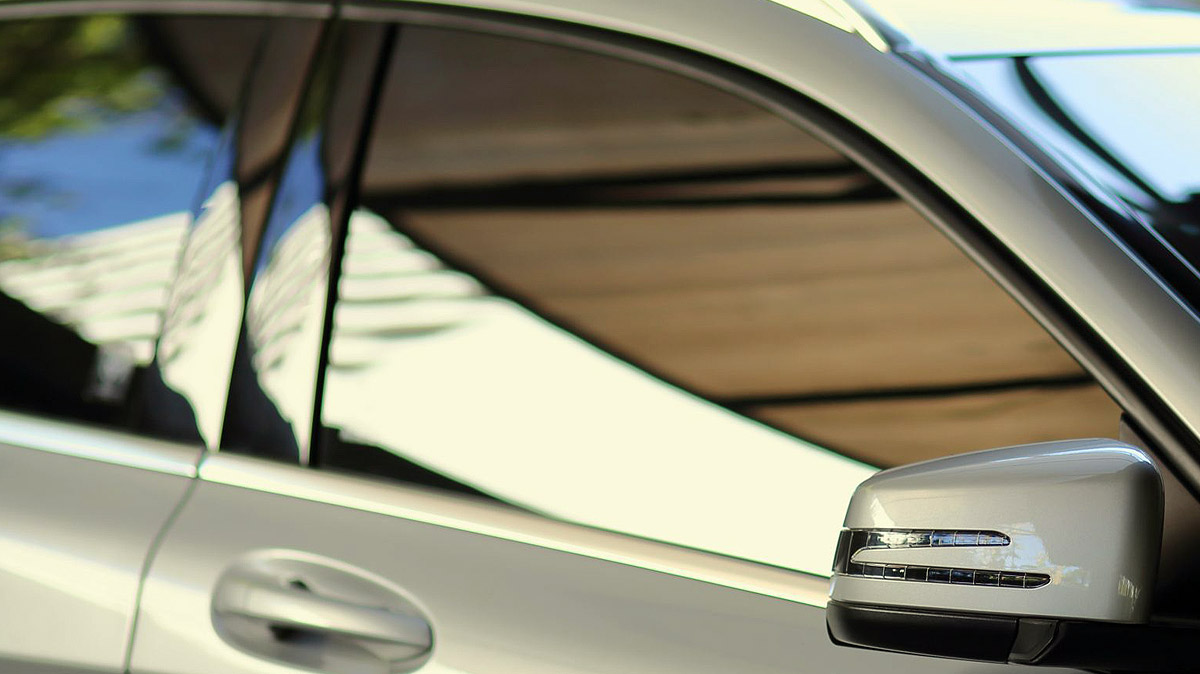
Mirror tint, a sought-after feature for both car and office windows, offers aesthetic appeal and daytime privacy. However, the question often arises when night falls: can you see through mirror tint at night? This question is crucial for both drivers and office occupants concerned about visibility after dark.
At night, the balance of internal and external lighting influences the ability to see through mirror tint. This factor varies in cars and offices, impacting how effectively one can see out. Exploring how light affects visibility through mirror tint is key, whether it’s applied to your car or office windows. Let’s delve deeper into these factors to help you make an informed decision about using mirror tint in different settings.
Explanation of One-Way Mirror Film
One-way mirror film, also known as mirror tint, is a unique window film applied to glass that offers a mirrored appearance from one side. This film is widely used in automotive and architectural settings, including cars and office windows. Its primary appeal lies in its ability to provide privacy and reduce glare and heat from the sun during the day.
Daytime Functionality
During daylight hours, one-way mirror film is highly effective. The film appears as a reflective mirror on the glass side exposed to sunlight (usually the exterior). This effect not only blocks a significant amount of sunlight but also prevents people from seeing inside the car or building. From the inside, however, the film is designed to be see-through, maintaining visibility for the occupants.
Light Behaviour with One-Way Mirror Film
The core principle behind the functionality of one-way mirror film is the behaviour of light. Light naturally travels from areas of higher intensity to lower intensity. During the day, the external environment is usually brighter than the interior of a car or office. This difference in light intensity makes the film reflective on the outside.
- Reflectivity and Brightness: The film works by reflecting light from its brighter side. When the outside is brighter, as it typically is during the day, the external surface of the film reflects the light, creating a mirror-like appearance.
- Visibility from Inside: Despite the external reflectivity, the film is designed to allow visibility from the inside. This is possible because the interior side of the film, facing less intense light, does not need to reflect it, thereby remaining more transparent.
Nighttime Visibility & Limitations: The Challenges of Seeing Through Mirror Tint
The straightforward answer is that it is generally not possible when it comes to nighttime visibility through mirror-tinted windows, whether in cars or offices. This limitation significantly contrasts the film’s daytime functionality and is primarily due to how light behaves in darker conditions.
Understanding the Limitation
At night, the dynamics of light change dramatically. The key factor here is the relative brightness inside compared to the outside environment. In most nighttime scenarios, the interior of a car or an office is brighter than the dark conditions outside. This reversal in light intensity leads to a critical issue:
- Internal Light Reflection: The internal lighting becomes the brighter source; consequently, the one-way mirror film reflects this light inside. This reflection creates a mirror effect on the interior surface of the window, preventing occupants from seeing out.
- Visibility Impairment: The reflection of internal light effectively obscures the view from inside to outside. This means that for drivers in cars or people in offices, the windows act more like mirrors, reflecting the interior environment rather than providing a view of the outside world.
Exceptions
There are, however, exceptions to this rule, albeit with limited effectiveness:
- Dual-Reflective Films: Some mirror tints are designed as dual-reflective films. These films have a less reflective interior surface, which can sometimes improve nighttime visibility. However, the improvement is often marginal and depends on the specific lighting conditions.
- External Lighting: Enhancing the external lighting can also aid in making the outside brighter than the inside. This can, to some extent, reduce the mirror effect and allow for better visibility. Yet, this solution is not always practical or sufficient, especially in environments where external lighting cannot be controlled or is inadequate.
Addressing Additional Concerns: Privacy and Alternatives at Night
Despite the challenges with visibility through mirror tint at night, it’s important to note that the privacy aspect remains largely intact. For those concerned about being seen from outside, mirror tint provides significant privacy after dark.
- Outside Reflection: At night, while the interior lighting hinders visibility from the inside out, the same lighting causes the window to appear reflective from the outside. This means that people outside will see their reflection instead of being able to see into the car or office.
- Maintained Privacy: Although occupants cannot see out, they can be assured that their privacy is kept from prying eyes outside. This feature is particularly beneficial for those who require consistent privacy in their vehicles or workplaces.
Alternatives for Nighttime Privacy
For individuals seeking enhanced privacy along with better nighttime visibility, there are alternative solutions:
- Curtains or Blinds: In office settings or even in some vehicles, curtains or blinds can be an effective alternative. They can be drawn at night to provide privacy while not impeding visibility when retracted.
- Practicality and Flexibility: Curtains and blinds offer the flexibility to adjust the level of privacy and visibility as needed. This adaptability is especially useful in changing light conditions, providing an effective solution when mirror tint falls short at night.
In summary, mirror tint offers privacy benefits at night due to its reflective nature on the outside. However, incorporating alternatives like curtains or blinds can be a practical and flexible solution for those seeking a balance between privacy and visibility after dark.

